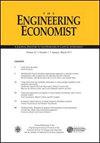经典均值-方差投资组合优化模型的扩展
IF 1.2
4区 经济学
Q4 BUSINESS
引用次数: 2
摘要
摘要本研究的目的是通过扩展经典的Markowitz均值-方差投资组合优化模型,找到一个在投资组合管理过程中经常面临约束的情况下,使风险调整收益最大化的投资组合。我们提出了一种新的两步启发式方法,GRASP&SOLVER,通过将资产的几个属性组合成一个参数来评估资产的可取性。使用真实的数据集,我们进行了一项模拟研究,将我们的解决方案与基准(标准普尔500指数)进行比较。我们发现,我们的方法在合理的计算时间内(不到一小时)生成了几乎满足所有约束的解决方案,而投资组合的年回报率却降低了13%,这突出了引入这些基于实践的约束的效果。本文章由计算机程序翻译,如有差异,请以英文原文为准。
An extension to the classical mean–variance portfolio optimization model
Abstract The purpose of this study is to find a portfolio that maximizes the risk-adjusted returns subject to constraints frequently faced during portfolio management by extending the classical Markowitz mean–variance portfolio optimization model. We propose a new two-step heuristic approach, GRASP & SOLVER, that evaluates the desirability of an asset by combining several properties about it into a single parameter. Using a real-life data set, we conduct a simulation study to compare our solution to a benchmark (S&P 500 index). We find that our method generates solutions satisfying nearly all of the constraints within reasonable computational time (under an hour), at the expense of a 13% reduction in the annual return of the portfolio, highlighting the effect of introducing these practice-based constraints.
求助全文
通过发布文献求助,成功后即可免费获取论文全文。
去求助
来源期刊

Engineering Economist
ENGINEERING, INDUSTRIAL-OPERATIONS RESEARCH & MANAGEMENT SCIENCE
CiteScore
2.00
自引率
0.00%
发文量
14
审稿时长
>12 weeks
期刊介绍:
The Engineering Economist is a refereed journal published jointly by the Engineering Economy Division of the American Society of Engineering Education (ASEE) and the Institute of Industrial and Systems Engineers (IISE). The journal publishes articles, case studies, surveys, and book and software reviews that represent original research, current practice, and teaching involving problems of capital investment.
The journal seeks submissions in a number of areas, including, but not limited to: capital investment analysis, financial risk management, cost estimation and accounting, cost of capital, design economics, economic decision analysis, engineering economy education, research and development, and the analysis of public policy when it is relevant to the economic investment decisions made by engineers and technology managers.
 求助内容:
求助内容: 应助结果提醒方式:
应助结果提醒方式:


